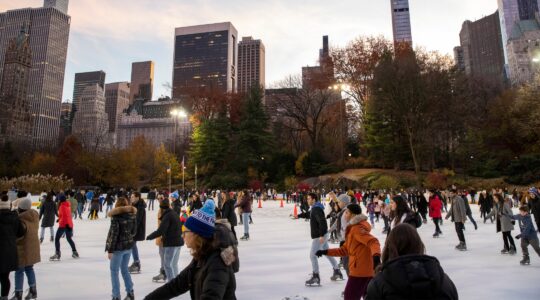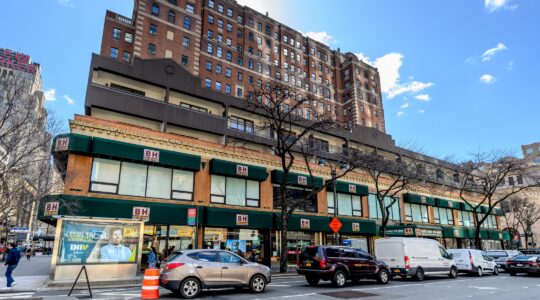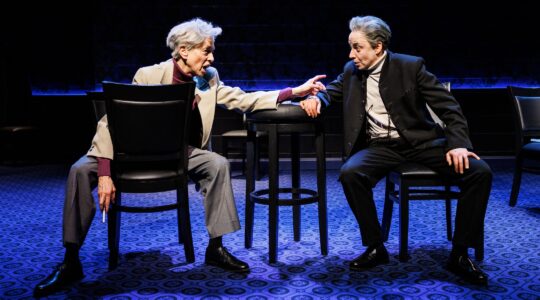Correction: A previous version of this story inadvertently attributed statements by Lisa Zahn Lazar to Dr. Robyn Horowitz Grossman. Statements by both women appear in an article in Jewish Action. The Jewish Week regrets the error.
The night is ending, a time, says the Talmud, when mothers nurse their babies and lovers talk in whispers. A sliver of light appears in the east but does nothing to chase the dark. In Brooklyn, Rabbi Moshe Elefant has already started his 5:40 a.m. Daf Yomi (daily page) Talmud class. Dawn puts on the rouge of sunrise at 7:17, but at Lincoln Square Synagogue the 6:15 Daf Yomi is wrapping up.
The Daf Yomi marathon, held in settings like these, in private homes and even online, is seven years and several months of daily study sessions, no days off, to finish 2,711 two-sided pages of Talmud; it will culminate Jan. 1 with the “Siyum HaShas” ceremony to be celebrated by 90,000 at MetLife Stadium in the Jersey Meadowlands, with 20,000 more at the Barclays Center.
Agudath Israel, the Orthodox umbrella group that started Daf Yomi in 1923 and has looked after it ever since, estimates that 350,000 are now doing Daf Yomi around the world, with more than 1,000 officially affiliated Daf Yomi groups in the United States alone.
It wasn’t always this way.
In a fascinating Agudah-supported documentary, “Only With Joy,” by David Lenik and Menachem Daum (onlywithjoy.org), the narrator says Jewish Europe in 1923 was “a world where respect for Torah was plummeting.” Rav Meir Shapiro, the Polish chasidic leader known as the Lubliner Rav, was only 36, and not yet prominent, when he suggested Daf Yomi in 1923 as an antidote to the crisis.
An old man, now deceased, echoes Jeremiah when he tells the filmmakers, “I am a person who witnessed the first Siyum” in 1931, with 20,000 in Lublin. “The Lubliner Rav came down, wearing his kolpik [round fur hat], and Shabbos clothes. He began the Siyum with such joy … like when King Solomon had a feast.”
At the second siyum in 1938, “The world was already darkening,” the old man remembers. “At the Third Siyum HaShas [1945], I saw nothing. It was a short time after the destruction. … I nearly cried. And I wondered, who will ever [again] experience a Siyum HaShas?”
In 1945, a lonely Siyum was held in Feldafing, Germany, by a few survivors in a Displaced Person’s camp. In 1953, the Siyum was held in places as small as the Young Israel of Borough Park.
Then came a revival as unlikely as Ezekiel’s Dry Bones. In 1997, there were 20,000 in Madison Square Garden. In 2012, 90,000 celebrated in MetLife Stadium.
Nevertheless, for all the surge, Daf Yomi is a demanding daily commitment undertaken by the few. The Modern Orthodox Lincoln Square Synagogue has several hundred members, but rarely do more than 10 show up for the daily Daf Yomi. Twenty for Daf Yomi would be a lot at the more “Yeshivish” Voorhand Shteible on West 91st Street.
Inspired by Agudath Israel, the Orthodox Union is the only other major organization to have thrown its weight behind Daf Yomi.
Although many romanticize pre-Holocaust Judaism, strict observance was dying before its practitioners were killed.
In “On The Eve,” a recent study of European Jews between the world wars, Bernard Wasserstein writes that World War I took hundreds of thousands of young Jewish men away from their Jewish lives, “often definitively and irretrievably.” Intermarriage was rampant. Single men were emigrating, or wandering Europe in search of work, losing themselves in the big cities. With Jewish men disappearing, Jewish women, even in the shtetl, were marrying later than a generation earlier; the average age for Jewish women to marry in Poland at the time was 27.
Wasserstein writes, “even in the traditional environment of the shtetl, the hold of the Orthodox … was beginning to fray.” There was “a distinct decline in the study of holy texts, particularly the Talmud.”
In all Poland, only 14 percent of Jewish male teenagers studied in yeshivas.
The Talmud, a legal and narrative compendium made up of the foundational Mishnah and the expansive commentary known as the Gemara, has long been the center of Jewish study. But Rav Shapiro had a new proposal for studying the Talmud that would unite the fraying community of learners.
Agudah allowed him to explain Daf Yomi at the 1923 Agudah convention, but, thinking himself too young and minor a figure, Shapiro asked the sympathetic Chofetz Chaim, among the most respected rabbis of that generation, to introduce Daf Yomi in his stead. The Choftez Chaim said, “No. We’ll work it this way. We’ll start the session. You walk in late. I will rise for you, and then the others will rise, seeing me giving you respect, and this way when it’s your time to speak, everyone will be paying attention.”
Rav Shapiro told the convention that with Jews leaving home, “If a Yid arrives in America, enters a shul, he’ll find them learning the very same daf as he’s learning. He’ll gladly join them.” He gave the once unimaginable examples of Jews travelling to Brazil or Japan. Jewish strangers, learning the same daf, or page, will be strangers no more.
Shapiro told the story from the Gemara Yevamos, Daf 121a, of Rabbi Akiva, who said he was saved from drowning after a shipwreck “because I held on to the daf” — daf being a synonym for a boat’s wooden plank as well as a page.
Nothing happened until a few weeks later on the night of Rosh HaShanah, when the Gerer Rebbe announced, “I’m going to learn Brachos Daf Beis,” the first page.
And so it began, one page after another, one cycle ending, a new one immediately beginning, as will happen 13 cycles later at MetLife Stadium next week.
Like The Super Bowl
Today, women are beginning to do Daf Yomi, too. This January, an all-women’s siyum will be held in Jerusalem. The OU’s Jewish Action monthly tells of a woman doing Daf Yomi on her Long Island Rail Road commute. And Lisa Zahn Lazar told Jewish Action that after learning Gemara at Manhattan’s Ramaz School, she heard of a Siyum HaShas, several cycles ago, made by the daughter of the Orthodox icon Rabbi Joseph Soloveitchik.
“That made a deep impression on me,” said Zahn Lazar, of Lawrence, N.Y. “Twenty-two years ago, when I was nine months pregnant, I began learning the Daf.”
Fred Ehrman, 83, an investment adviser and security analyst for 57 years, started Daf Yomi around 30 years ago. He will be at the stadium, a few rows from the top, celebrating his fourth cycle, and beginning his fifth. “It’s exciting; you have 90,000 people in one stadium, and with the same feeling and connection to Torah. Having so many people coming together is almost unprecedented in the history of the Jewish people.”
To Ehrman, “one of the most thrilling moments is when the Hadran and Kaddish is said for the siyum.” The Hadran is a prayer recited at the completion of a tractate of Talmud, promising the learner will “return” to the just-finished book, “and You will return to us… in this world and the next.” The Kaddish, the same optimistic prayer said at burials, is answered by 90,000 people saying, “Yehay Shmay Rabba Mevarach,” praising God’s name. “I get an emotional reaction to that,” said Ehrman.
When he studies, “I first ask myself, what is the Gemara trying to tell me?” Going through all 2,711 pages of stories, rabbinic conversations and differing opinions, “you get such a different perspective on what Torah is really about, It’s not just the Ten Commandments or the 613 mitzvot, but how do we get there? How do we live our lives? The ordinary person who comes to [a Daf Yomi on a Shabbos afternoon], the Aggadita (the non-legal discussions) really grabs him. I love Aggadita. People are searching for something that will affect their souls, and the daily Daf is one of those things.”
Barry Shain, who’ll be at the stadium, remembers going to the Siyum in 1997 with his father. “He brought the program back home and everyone was jealous of him, like he went to the Super Bowl. I’m going with my kids this year, and that means a lot to me. If they see you watching football, theyll watch football. Your kids see you learning, that it’s important to you, it’ll be important to them.”
Shain says that Daf Yomi his illuminated the joy of Yom Kippur, a holy day he never quite appreciated before. He speaks with excitement about Talmudic discussions about what the dead know about the living, and ghost stories from the Other World, and even sexual stories from the underworld.
And, Shain says, echoing Rav Shapiro’s dream, “And when I’m traveling and see a Jew with a Gemara, I can start a conversation over what we’re learning. It’s a book club, but a sacred book.”
The New York Jewish Week brings you the stories behind the headlines, keeping you connected to Jewish life in New York. Help sustain the reporting you trust by donating today.




